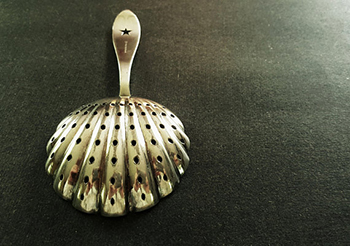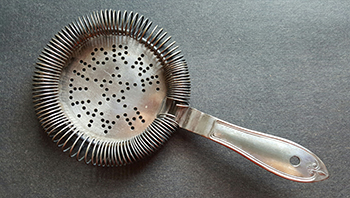The strainer is held in high regard by two types of professional: bartenders and colonic nurses.
Only one of these professions however use it to produce something worth drinking (unless you are in the Luton Airport Wetherspoons in which case the lines are slightly more blurred). But where did the strainer come from?

If you think about using a strainer, either Julep or Hawthorne, in your bar the timing of its appearance in the world of drinks becomes obvious. It’s all about the ice. Before ice became available in the US and around the world in the mid-1800’s, thanks to Frederic Tudor, drinks were mixed and served warm or room temperature with no need to strain (generally mixed or thrown).
With the trend for ice came the advent of julep and cobbler style drinks and therefore the first type of strainer, the Julep (an evolution of tea strainers and spoons which were originally used and had been around for a long time), although it didn’t become common place until later in the century. You will have probably heard the story of how julep strainers were used to keep the ice away from the rotten teeth of the people of the age. Like so many ‘facts’ in our industry this, however, doesn’t really add up.
For anyone who has suffered from sensitive teeth ice is pretty painful, but so is ice-cold liquid and the Julep strainer only solves one of those issues. There was already an earlier invention which solved this problem completely… the straw. There was however something else as prevalent as shitty chompers at this time, the fancy moustache. This has now taken over as the main reason for the rise of the Julep strainer amongst those in the know: the strainer stopping the saggy walrus top lip effect. There was however once again an earlier invention that solved this problem… the straw!
The final explanation for this trend is to keep the extravagant mints and fruit garnishes away from your face, annnnnddddddd…… the straw.
So it appears no-one really knows, however if we had to put our money on one reason it would be simply that it was cool. Around this time silver julep strainers became popular wedding gifts and with fancy moustache’s being a status symbol it would make sense that a fancy julep strainer would be equally as sought after. Perhaps we will soon be seeing facial hair covered hipsters carrying a julep strainer around their necks and talking about how they picked it up at a flea market in a small village in Cambodia.
As the trend moved away from crushed ice serves to more classic stirred down drinks such as the Martini and Manhattan, the julep strainer’s limitations began to show. The main issue was it took a very particular size of mixing glass for the julep not to become a messy and ineffective tool. Something needed to be done, damn it.
So enter the Hawthorne strainer. Now because people are dicks when, in 1889, the first patent was put in for what we now know as the Hawthorne strainer it was called the ‘Julep strainer’. In fact there were many designs and patents put in around this time for various designs of strainers but it was the Hawthorne with its spring and punched holes that quickly became the bartenders’ favourite.

The name of the Hawthorne didn’t come from it’s inventor, William Wright, but from a bar in Boston. At first this seemed like yet another bit of false information that has become common place, but apparently the patent was actually given to a bloke named Denny P. Sullivan who owned The Hawthorne Cafe in Boston. From there the name stuck.
Having a look through some of the many other patents that were granted at the time the Hawthorne strainer stands out for two main reasons. Firstly the coil which up until this point had not been featured on any other patent we could find, it was described to “be released in a moment, cleaned of any fruit seeds or shreds, and as readily replaced.” It also had the advantage of helping the strainer “to instantly fit any glass,”.
The longer handle is also a reasonably rare feature with most having a small handle that simply clipped over the glass or shaker. Both of these lean towards a tool that was designed if not by bartenders certainly with them in mind and with an understanding of the craft. Many of the others look like an extension of the Julep strainer for personal use.
The word Hawthorne was not originally spelled out with the wee holes although it didn’t take long, it did take longer for the little ears to emerge however. According to David Wondrich (and we are not one to argue with him when it comes to dates) in his book Imbibe! it wasn’t until the early 20th century that the ears started to emerge.
So there you have it. The strainer. Unchanged, apart from a couple of extra bits of metal, for over 125 years. Invented to make your life easier. Does it need updating? Or is it still the perfect tool for the job?


